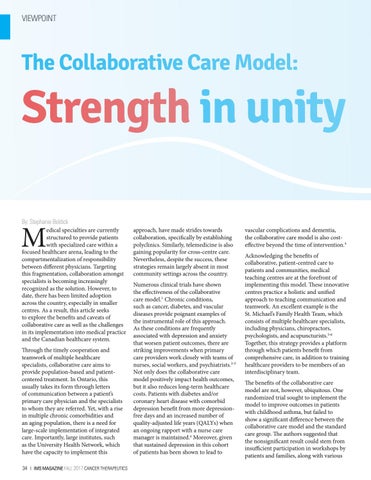VIEWPOINT
The Collaborative Care Model:
Strength in unity By: Stephanie Beldick
M
edical specialties are currently structured to provide patients with specialized care within a focused healthcare arena, leading to the compartmentalization of responsibility between different physicians. Targeting this fragmentation, collaboration amongst specialists is becoming increasingly recognized as the solution. However, to date, there has been limited adoption across the country, especially in smaller centres. As a result, this article seeks to explore the benefits and caveats of collaborative care as well as the challenges in its implementation into medical practice and the Canadian healthcare system. Through the timely cooperation and teamwork of multiple healthcare specialists, collaborative care aims to provide population-based and patientcentered treatment. In Ontario, this usually takes its form through letters of communication between a patient’s primary care physician and the specialists to whom they are referred. Yet, with a rise in multiple chronic comorbidities and an aging population, there is a need for large-scale implementation of integrated care. Importantly, large institutes, such as the University Health Network, which have the capacity to implement this 34 | IMS MAGAZINE FALL 2017 CANCER THERAPEUTICS
approach, have made strides towards collaboration, specifically by establishing polyclinics. Similarly, telemedicine is also gaining popularity for cross-centre care. Nevertheless, despite the success, these strategies remain largely absent in most community settings across the country. Numerous clinical trials have shown the effectiveness of the collaborative care model.1 Chronic conditions, such as cancer, diabetes, and vascular diseases provide poignant examples of the instrumental role of this approach. As these conditions are frequently associated with depression and anxiety that worsen patient outcomes, there are striking improvements when primary care providers work closely with teams of nurses, social workers, and psychiatrists.2-3 Not only does the collaborative care model positively impact health outcomes, but it also reduces long-term healthcare costs. Patients with diabetes and/or coronary heart disease with comorbid depression benefit from more depressionfree days and an increased number of quality-adjusted life years (QALYs) when an ongoing rapport with a nurse care manager is maintained.4 Moreover, given that sustained depression in this cohort of patients has been shown to lead to
vascular complications and dementia, the collaborative care model is also costeffective beyond the time of intervention.4 Acknowledging the benefits of collaborative, patient-centred care to patients and communities, medical teaching centres are at the forefront of implementing this model. These innovative centres practice a holistic and unified approach to teaching communication and teamwork. An excellent example is the St. Michael’s Family Health Team, which consists of multiple healthcare specialists, including physicians, chiropractors, psychologists, and acupuncturists.5-6 Together, this strategy provides a platform through which patients benefit from comprehensive care, in addition to training healthcare providers to be members of an interdisciplinary team. The benefits of the collaborative care model are not, however, ubiquitous. One randomized trial sought to implement the model to improve outcomes in patients with childhood asthma, but failed to show a significant difference between the collaborative care model and the standard care group. The authors suggested that the nonsignificant result could stem from insufficient participation in workshops by patients and families, along with various
